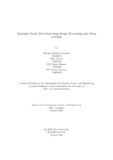| dc.contributor.advisor | Rodoshi, Ahnaf | |
| dc.contributor.advisor | Mostafa, Nafis | |
| dc.contributor.author | Swadesh, Shimran Mahbub | |
| dc.contributor.author | Ahmed, Rifat | |
| dc.contributor.author | Hossain, MD. Imran | |
| dc.contributor.author | Rahman, MD. Raihan | |
| dc.date.accessioned | 2022-11-21T05:14:56Z | |
| dc.date.available | 2022-11-21T05:14:56Z | |
| dc.date.copyright | 2022 | |
| dc.date.issued | 2022-01 | |
| dc.identifier.other | ID: 21341029 | |
| dc.identifier.other | ID: 18101710 | |
| dc.identifier.other | ID: 17201093 | |
| dc.identifier.other | ID: 18101169 | |
| dc.identifier.uri | http://hdl.handle.net/10361/17596 | |
| dc.description | This thesis is submitted in partial fulfillment of the requirements for the degree of Bachelor of Science in Computer Science, 2022. | en_US |
| dc.description | Cataloged from PDF version of thesis. | |
| dc.description | Includes bibliographical references (pages 41-42). | |
| dc.description.abstract | Computer Science has evolved enormously in the last few decades. It has now far
exceeded the Human and Computer interfaces. Its recent sights are scaling, measuring, object detection, etc. Image processing and deep learning have gone through
many groundworks in the last few years. Our research paper, based on YOLO V4,
LeNet-5, Retina Net, and Faster-RCNN algorithms, proves that these algorithms
can detect damaged roads and analyze whether we can enhance any new ways to
improve the damaged road detection in real-time. However, in a real-world scenario,
it is essential to comprehend the various damages in taking the appropriate action.
Thus automotive industries are looking forward to innovations that can increase the
efficiency in damage categorization.
Along with worldwide industrialization, road damage detection systems have become significantly important both in terms of maintenance and establishment. As
the Artificial Intelligence sector is making a lot of progress, faulty road detection
through Image Processing and Machine Learning has proved to be a flourishing
technique. We can detect damaged roads within specific provisional categories with
combinations of such technological stems. In our solution, we propose a futuristic
deep learning method for object recognition with the help of four different algo rithms. More specifically, our approach uses a convolutional neural network to train
our model with a large dataset solely made for the project and categorize the results
into a set of damages along with its comparative analysis. | en_US |
| dc.description.statementofresponsibility | Shimran Mahbub Swadesh | |
| dc.description.statementofresponsibility | Rifat Ahmed | |
| dc.description.statementofresponsibility | MD. Imran Hossain | |
| dc.description.statementofresponsibility | MD. Raihan Rahman | |
| dc.format.extent | 42 Pages | |
| dc.language.iso | en_US | en_US |
| dc.publisher | Brac University | en_US |
| dc.rights | Brac University theses are protected by copyright. They may be viewed from this source for any purpose, but reproduction or distribution in any format is prohibited without written permission. | |
| dc.subject | Index Terms—Deep Learning | en_US |
| dc.subject | Road Crack Detection | en_US |
| dc.subject | Categorization | en_US |
| dc.subject | Object Recognition | en_US |
| dc.subject | Transfer Learning and RELU | en_US |
| dc.subject.lcsh | Deep learning (Machine learning) | |
| dc.subject.lcsh | Image processing -- Digital techniques | |
| dc.subject.lcsh | Cognitive learning theory (Deep learning) | |
| dc.title | Damaged road detection using Image Processing and Deep Learning | en_US |
| dc.type | Thesis | en_US |
| dc.contributor.department | Department of Computer Science and Engineering, Brac University | |
| dc.description.degree | B. Computer Science | |

